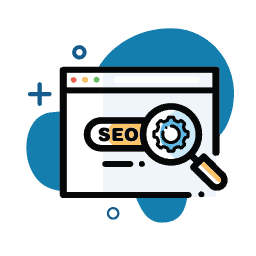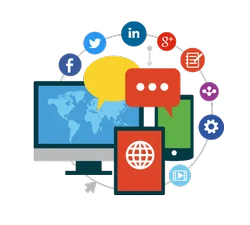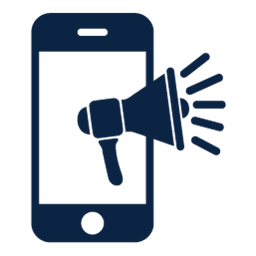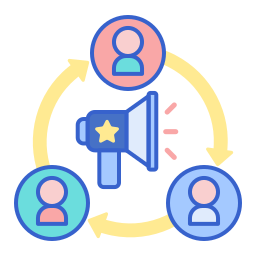Learn what Digital marketing is and how it works. An introduction to digital marketing in simple words.
Digital marketing, also known as Online Marketing is the practice of promoting a business through online channels like Search Engine Optimization, Social Media Marketing, Pay-Per-Click, and Email Marketing.
Digital Marketing provides a powerful and cost-effective way to drive revenue.
Online marketing has become the go-to marketing strategy for small businesses and enterprises. You’ve probably heard about digital marketing before, but it encompasses many different strategies for businesses.
Online marketing is a vast umbrella term that covers multiple areas, from SEO to blog writing and distribution channels to budgets.
This post will cover everything you need to know about digital marketing, including its benefits, the various types, and how digital marketing works.
Here’s a quick overview of everything we’re going to cover:
- What is Digital Marketing?
- Benefits of Digital Marketing
- Types of Digital Marketing
- How does Digital Marketing work?
Digital Marketing Definition
Digital Marketing refers to the use of digital channels, platforms, and technologies to promote and advertise products, services, or brands to a targeted audience.
Also referred to as Internet Marketing, it has become an integral part of modern business strategies due to the widespread use of the Internet and the increasing reliance on digital devices by consumers.
Digital Marketing also includes offline channels that include digital media as well.
The growth of digital media and digital platforms has made digital marketing the most potent form of marketing. Even traditional channels are changing to fit more digital media into them, and that emphasizes its importance in a modern-day marketing strategy.
Benefits of Digital Marketing
Internet marketing offers a wide range of benefits that can greatly impact businesses of all sizes and industries. Here are some key advantages of incorporating digital marketing into your overall marketing strategy:
- Global Reach and Accessibility
- Cost-effectiveness and Efficient Resource Allocation
- Precise Audience Targeting
- Real-Time Analytics and Measurable Results
- Personalization and Enhanced Customer Experience
- Interactivity and Engagement
- Brand Building and Recognition
- Flexibility and Adaptability
- Data-Driven Decision Making
- Leveling the Playing Field
- Diverse Content Formats
- Search Engine Visibility
1. Global Reach and Accessibility: Digital marketing erases geographical boundaries, allowing businesses to connect with audiences worldwide.
Unlike traditional marketing methods that are limited by physical location, Digital Marketing enables businesses to tap into new markets and expand their reach without the need for a physical presence.
This global accessibility opens up unprecedented opportunities for growth and market expansion.
2. Cost-Effectiveness and Efficient Resource Allocation: Compared to traditional marketing channels such as TV, radio, and print media, Digital Marketing offers cost-effective alternatives.
Online advertising platforms, like social media and search engines, allow businesses to set precise budgets, target specific demographics, and pay only when users engage with their ads.
This level of control ensures that resources are allocated efficiently, maximizing the return on investment.
3. Precise Audience Targeting: Digital marketing provides advanced tools to segment and target specific audiences based on demographics, behaviors, interests, and more.
This precision ensures that marketing efforts are directed at individuals who are more likely to be interested in the product or service, increasing the chances of conversion.
By understanding the audience better, businesses can create tailored campaigns that resonate with their potential customers.
4. Real-Time Analytics and Measurable Results: One of the most significant advantages of Digital Marketing is its ability to provide real-time data and analytics.
Marketers can track key performance indicators (KPIs) such as website traffic, click-through rates, conversion rates, and more. This data helps them measure the effectiveness of their campaigns and make data-driven decisions.
Adjustments can be made on the fly to optimize strategies for better outcomes.
5. Personalization and Enhanced Customer Experience: Digital marketing allows businesses to create personalized experiences for their customers.
By analyzing user data and behavior, marketers can deliver tailored content and offer that resonate with individual preferences. This personalized approach not only increases engagement but also enhances the overall customer experience, leading to higher customer satisfaction and loyalty.
6. Interactivity and Engagement: Social media and other digital platforms provide avenues for direct interaction between brands and customers. This engagement goes beyond mere advertising; it’s about building meaningful relationships.
Brands can respond to customer inquiries, address concerns, and engage in conversations. Interactive content formats like polls, quizzes, and contests further boost engagement and encourage user participation.
7. Brand Building and Recognition: Consistent Digital Marketing efforts contribute to brand building and recognition.
By maintaining an active online presence through social media, content marketing, and other strategies, brands become more familiar to consumers.
This familiarity fosters trust and credibility, making customers more likely to choose a well-recognized brand over competitors.
8. Flexibility and Adaptability: In the rapidly evolving digital landscape, agility is key. Digital marketing campaigns can be adjusted in real-time based on performance data. If a particular strategy isn’t delivering the desired results, changes can be implemented swiftly.
This flexibility allows businesses to respond to changing market dynamics, consumer preferences, and emerging trends effectively.
9. Data-Driven Decision-Making: Digital marketing relies on data and analytics to guide decision-making. The wealth of information available helps marketers understand what works and what doesn’t.
By analyzing data trends, businesses can refine their strategies, allocate resources more effectively, and tailor their messaging to align with consumer behaviors.
10. Leveling the Playing Field: Digital marketing offers smaller businesses the chance to compete with larger players. Innovative and creative strategies can help smaller brands gain visibility and traction without the need for massive advertising budgets.
A well-executed digital marketing campaign can help a smaller business carve out its niche and attract a dedicated customer base.
11. Diverse Content Formats: Digital marketing supports various content formats, catering to different audience preferences.
From videos and infographics to blog posts and podcasts, businesses can choose the format that resonates most with their target audience.
This diversity ensures that the brand’s message is conveyed effectively across different platforms and channels.
12. Search Engine Visibility (SEO): Effective search engine optimization (SEO) techniques enhance a brand’s visibility on search engine result pages. By optimizing their website’s content and structure, businesses can increase their chances of appearing in relevant search queries.
This organic visibility drives consistent traffic to the website and helps establish the brand as an authoritative source within its industry.
In today’s digital age, where consumers are increasingly connected online, digital marketing has become an essential tool for businesses seeking to thrive and succeed.
The benefits of global reach, cost-effectiveness, precise targeting, and real-time analytics provide businesses with the tools they need to engage with their audience, build brand loyalty, and achieve their marketing goals.
As technology continues to advance, embracing and adapting to the opportunities presented by digital marketing will be crucial for staying competitive and relevant in the ever-evolving marketplace.
Types of Digital Marketing
There are various types of Digital Marketing Strategies, each with its own unique approach and benefits. Here’s an explanation of some of the most common types of digital marketing:
- Search Engine Optimization(SEO):

Search Engine Optimization (SEO) is a digital marketing strategy that focuses on optimizing your website’s content, structure, and technical aspects to improve its visibility in Search Engine Results Pages (SERPs).
The primary goal of SEO is to attract organic (unpaid) traffic to your website by ranking higher for relevant keywords that your target audience uses to search for products, services, or information.
2. Content Marketing:

Content Marketing is all about content. The digital world is a huge collection of content in different forms like text, images, audio, and videos.
Content marketing is a strategic approach to creating and distributing valuable, relevant, and consistent content to attract and engage a target audience.
It’s a powerful way to build brand awareness, establish authority, and drive customer loyalty.
Content is usually published on a website and then promoted through social media, email marketing, SEO, or even on PPC campaigns.
The difference between having a blog versus running a content marketing campaign is that the latter has specific goals as to what content to publish and when to publish it, who to target, and how to monitor the effectiveness of your content campaigns.
3. Social Media Marketing(SMM):

Social media marketing is a strategy that involves using social media platforms to connect with your target audience, build brand awareness, promote products or services, and engage users through various forms of content.
SMM leverages the power of social media to create meaningful relationships and interactions with customers, prospects, and followers.
Social media marketing encompasses a range of activities and goals, and it’s a vital component of modern digital marketing strategies.
4. Website Marketing:

Website marketing refers to the strategies and tactics that businesses use to promote their products, services, or brand through their website. It involves various techniques aimed at driving traffic to the website, engaging visitors, and converting them into customers.
Your website should represent your brand, products, and services in the best possible way. It should be fast, mobile-friendly, and easy to use.
Once you have a website, your next step is to come up with a digital marketing strategy to promote your website and content with the purpose of getting more traffic and customers.
5. Pay-Per-Click(PPC):

PPC stands for “Pay-Per-Click,” which is an online advertising model where advertisers pay a fee each time their ad is clicked. It’s a way to buy visits to your website rather than attempting to earn those visits organically through methods like search engine optimization (SEO).
In PPC advertising, advertisers bid on specific keywords relevant to their business. When a user enters a search query that matches these keywords, the advertiser’s ad may appear on the search engine results page (SERP) or on other websites that participate in the ad network.
If the user clicks on the ad, the advertiser pays a predetermined amount to the advertising platform.
6. Email Marketing:

Email marketing is a strategy that involves sending targeted emails to a group of recipients with the goal of building relationships, promoting products or services, and achieving various business objectives.
Email Marketing is a direct and personalized way to communicate with your audience and nurture leads throughout their customer journey.
Many successful businesses and marketers use all the other digital marketing channels to add leads to their email lists, and then through email marketing, they create a number of funnels to turn those leads into customers.
7. Affiliate Marketing:

Affiliate marketing is a performance-based marketing strategy where businesses partner with individuals or other businesses (affiliates) to promote their products or services.
Affiliates earn a commission for every sale, lead, or action generated through their marketing efforts.
Affiliate Marketing is a mutually beneficial arrangement where businesses can expand their reach, and affiliates can earn income by promoting products they believe in.
Many well-known companies like Amazon have affiliate programs that pay out millions of dollars per month to websites that sell their products.
When designing your digital marketing strategy, you should include affiliate marketing as a way to get people involved in your brand and sell your products for a commission.
8. Mobile Marketing:

Mobile marketing is a strategy focused on reaching and engaging users through their mobile devices, such as smartphones and tablets.
Mobile Marketing involves delivering targeted content, promotions, and messages to users while they are on the go, using various mobile channels and technologies.
With mobile marketing, businesses reach out to subscribers via SMS messaging. Since most of us have our phones on us 24/7 no matter where we are, mobile marketing makes it possible for businesses to send timely messages.
Like email marketing, mobile marketing gives you a one-on-one connection with your customers.
9. Video Marketing:

Video marketing is a strategy that involves creating and sharing videos to promote products, services, or brands.
It’s a powerful way to engage and communicate with your target audience through visual storytelling, demonstrating products, sharing information, and conveying emotions.
YouTube is the most obvious place to do video marketing, but social media platform like Instagram is also great for promoting your brand with videos
Video content is valuable to so many users, so tap into this growing area of digital marketing. If you have a smartphone, you have the capability to make quality videos for your company’s website, social media, email campaigns, and paid ads.
10. Influencer Marketing:

Influencer marketing is a marketing strategy that involves collaborating with individuals who have a significant and engaged following on social media or other online platforms.
These individuals, known as influencers, have the ability to sway the opinions and behaviors of their audience due to their expertise, credibility, and authority in a specific niche or industry.
Influencer marketing is different from Affiliate Marketing because it doesn’t involve profit sharing. Instead, you typically pay the influencer a flat fee in exchange for promoting your product.
With this digital marketing strategy, the influencer is paid regardless of sales related to their promotion. You can certainly add an affiliate spin to the arrangement to incentivize sales, but it isn’t necessary.
How does Digital Marketing work?
You know the definition of digital marketing, but how does Digital Marketing work?
Digital marketing is a strategy that uses various online channels and platforms to promote products, services, or brands to a target audience.
It involves leveraging the power of the internet and digital technologies to reach potential customers, engage with them, and ultimately drive desired actions, such as making a purchase or subscribing to a service.
Here’s how digital marketing generally works:
- Identifying Goals and Target Audience: The first step is to define your marketing goals. These could be increasing brand awareness, driving website traffic, generating leads, boosting sales, or any other specific objective. Additionally, you need to identify your target audience – the group of people most likely to be interested in your offerings.
2. Creating Content and Assets: Depending on the chosen channels, you’ll need to create various types of content and assets, such as blog posts, social media posts, videos, graphics, landing pages, and more. The content should be tailored to your audience’s interests and preferences.
3. Executing Campaigns: Implement your digital marketing campaigns by publishing and promoting your content across the selected channels. This could involve setting up paid ads, scheduling social media posts, optimizing your website for search engines, and more.
4. Engagement and Interaction: As your content reaches your target audience, you’ll start to receive engagement – likes, shares, comments, clicks, etc. Engaging with your audience by responding to comments and messages helps build rapport and trust.
5. Data Collection and Analysis: Digital Marketing provides a wealth of data that can be analyzed to measure the success of your campaigns. Metrics like website traffic, conversion rates, click-through rates, social media engagement, and more can help you understand what’s working and what needs improvement.
6. Optimization: Based on the data analysis, you can make informed decisions to optimize your campaigns. This might involve adjusting targeting parameters, refining ad copy, modifying content strategies, and more.
7. Iterating and Scaling: Digital marketing is an iterative process. You learn from each campaign’s results and apply those lessons to future campaigns. As you gather more data and refine your strategies, you can scale your efforts to reach a larger audience effectively.
Remember that digital marketing is a dynamic field that evolves with changes in technology and consumer behavior. Staying updated with the latest trends and best practices is essential for achieving long-term success.
To sum it up, digital marketing is like a superpower for businesses in today’s digital age. It helps them connect with people online, understand what they like, and show them products or services they might enjoy.
Just like superheroes have different tools and abilities, digital marketing has various methods like social media, websites, and online ads. By using these tools wisely and keeping up with changes, businesses can stay ahead in the ever-changing online world and make more people happy customers.
